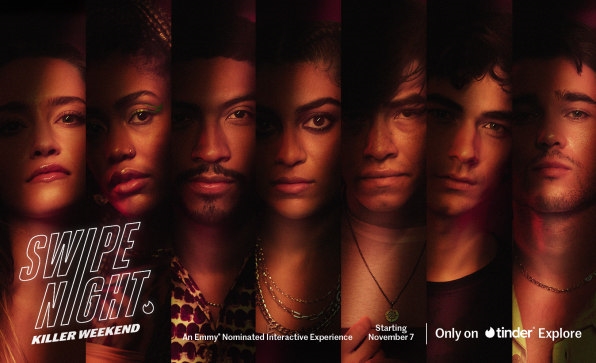Tinder’s new ‘Swipe Night’ whodunit points to the future of shared digital experiences
When Tinder debuted its interactive dating experience Swipe Night in 2019, Kyle Miller, the company’s VP of product, core experience, recognized the risk of wrapping Tinder’s primary function—creating matches among its millions of users, 10.4 million of which are paying customers as of parent company Match Group’s third-quarter earnings—in what could’ve been seen as a trendy gimmick under the discerning gaze of the platform’s core demo of Gen Z.

[Photo: courtesy of Tinder]
“Tinder is so iconic in the way that it’s created today that it’s scary to do something different,” Miller says. “They’ve experienced Tinder in a very specific way over the last eight years. Do people want this?”
Turns out they do.
Globally, 20 million Tinder users participated in first iteration of Swipe Night and saw a 26% increase in matches.
“One of the big learnings for us is that there was a lot of demand for shared experiences on Tinder, even on a global scale,” Miller says.
The focus now with the latest Swipe Night is how to elevate those experiences.
In Swipe Night: Killer Weekend, you’re invited to a birthday party where the man of honor is murdered. Any one of the six guests is a suspect, and it’s up to you to figure out who did it.
The decision to make a murder mystery was in direct response to a 20% uptick in Tinder users mentioning an interest in true crime in their bios.
But, more importantly to Miller, a whodunit is more likely to generate more in-depth conversations than Swipe Night‘s original story about a party interrupted by the apocalypse.

“Season one was an icebreaker value proposition: Did you save the puppy or not? How did you find [rapper] Rico Nasty in the story?” he says. “But mystery is really a natural conversation starter.”
Killer Weekend also takes into consideration the action that’s happening outside your direct point of view.
“What’s happening onscreen and offscreen are just as important compared to the last round we did,” Miller says. “And so we had to think extremely hard about a timeline of a narrative where you might’ve gone to the kitchen instead of going to the pool, but the scene would be the same, just in different points of view.”
Upping Swipe Night‘s breadth of storytelling feeds into the actual dating component of the experience, which Miller notes has also been revamped to facilitate more conversation.

After an episode, there’s a prompt asking who you think the top suspect is and users are paired with someone who’s not their direct match, i.e. they made similar choices during the episode but they chose a different top suspect.
“It’s almost like ‘change my mind,’” Miller says. “That is a special part of this season—we’re opening up the conversations going right after the episode instead of waiting for you to get a match and then start a conversation that way, which you’ll still be able to do. But coming out of a cliffhanger, our members, we figured, would have that urge to be like, ‘I need to talk to someone about this!’”

Swipe Night was Tinder’s first major pass at facilitating shared experiences on the platform, and it’s opened the door for other in-app events including Vibes (answering a rapid-fire questions that will match you with someone similar) and Hot Takes (being able to chat with someone before you match with somewhat spicy prompts kicking off the conversation).
But neither are quite as involved as Swipe Night.
Incorporating narrative entertainment into the platform’s core service—and having it being received so well among users, as well as earning an Emmy nomination—signals a shift in how Tinder is positioning itself in the market.

“At first [Swipe Night] was kind of a proof of concept of creating more ways to connect our members, to reach them where they’re at,” Miller says. “What Swipe Night represents at large now is pushing us into a realm of how to think about digital shared experiences on Tinder.”
He adds, “We see Swipe Night as a driving force of what the potential future Tinder is to come.”
(35)



